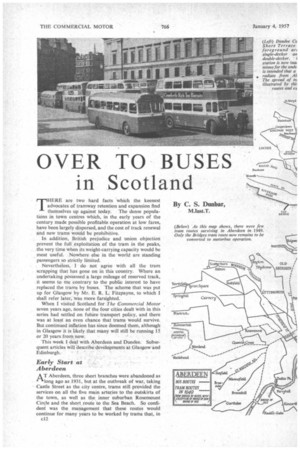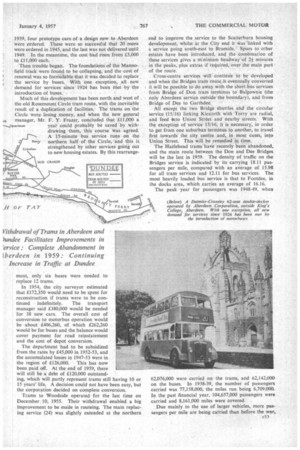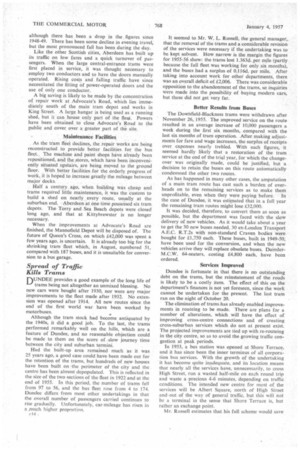OVER TO BUSES in Scotland
Page 52

Page 53

Page 54

Page 55

If you've noticed an error in this article please click here to report it so we can fix it.
THERE are two hard facts which the keenest advocates of tramway retention and expansion find themselves up against today. The dense populations in town centres which, in the early years of the century made possible profitable operation at low fares, have been largely dispersed, and the cost of track renewal and new trams would be prohibitive.
In addition, British prejudice and union objection prevent the full exploitation of the tram in the peaks, the very time when its weight-carrying capacity would be most useful. Nowhere else in the world are standing passengers so strictly limited.
Nevertheless, I do not agree with all the tram scrapping that has gone on in this country. Where an undertaking possessed a large mileage of reserved track, it seems to me contrary to the public interest to have replaced the trams by buses. The scheme that was put up for Glasgow by Mr. E. R. L: Fitzpayne, to which I shall refer later, was more farsighted.
When I visited Scotland for The Commercial Motor seven years ago, none of the four cities dealt with in this series had settled on future transport policy, and there was at least an even chance that trams would survive. But continued inflation has since doomed them, although in Glasgow it is likely that many will still be running 15 or 20 years from now.
This week I deal with Aberdeen and Dundee. Subsequent articles will -describe developments at Glasgow and Edinburgh.
Early Start. at Aberdeen A T Aberdeen, three short branches were abandoned as 1-1long ago as 1931, but at the outbreak of war, taking Castle Street as the city centre, trams still provided the services on all the five main arteries to the outskirts of the town, as well as the inner suburban Rosemount Circle and the short route to the Sea Beach. So confident was the management that these routes would continue for many years to be worked by trams that, in
c12 1939, four prototype cars of a design new to Aberdeen were ordered. These were so successful that 20 more were ordered in 1945, and the last was not delivered until 1949_ In the meantime, the cost had risen from £5,000 to £11,000 each_ Then trouble began. The foundations of the Mannofield track were found to be collapsing, and the cost of renewal was so formidable that it was decided to replace the service by buses. With one exception, all new demand for services since 1924 has been met by the introduction of buses.
Much of this development has been north and west of the old Rosemount Circle tram route, with the inevitable result of a duplication of facilities. The trams on the Circle were losing money, and when the new general manager, Mr. F. Y. Frazer, concluded that £11,000 a year could probably be saved by withdrawing them, this course was agreed. A 15-minute bus service runs on the nnt7 northern half of the Circle, and this is
LinlJthert strengthened by other services going out to new housing estates. By this rearrange
ment, only six buses were needed to replace 12 trams.
In 1954, the city surveyor estimated that £172,350 would need to be spent for reconstruction if trams were to be continued indefinitely. The transport manager said £380,000 would be needed for 38 new cars. The overall cost of conversion to motorbus operation would be about £406,260, of which £262,260 would be for buses and the balance would cover payment for road reinstatement and the cost of depot conversion.
The department had to be subsidized from the rates by £45,000 in 1952-53, and the accumulated losses in 1947-53 were in the region of £126,000. This has now
been paid off. At the end of 1959, there L. will still be a debt of £120,000 outstanding, which will partly represent trams still having 10 or 15 years' life. A decision could not have been easy, but the corporation decided on complete conversion.
Trams to Woodside operated for the last time on December 10, 1955. Their withdrawal enabled a big
improvement to be made in routeing. The main replacing service (24) was slightly extended at the northern
end to improve the service to the Scatterburn housing development, whilst at the City end it Was 'linked with a service going south-east to Braeside. Spurs to other estates have been introduced, and the combination of these services gives a m:nimurn headway of 2+ minutes in the peaks, plus extras if required, over the main part of the route.
Cross-centre services Will continue to be developed and when the Bridges tram route,is eventually converted it will be possible to do away with the short bits services from Bridge of Don tram terminus to Balgownie (the only Aberdeen service outside the boundary), and from -Bridge of Dee to Garthdee.
All except the two Bridge shuttles and the circular service (15/16) linking Kincorth with Torry are radial, and feed into Union Street and nearby streets. With the exception of service 1.5/16, it is necessary, in order to get from one suburban terminus to another, to 'travel first towards the city centre and, in most cases, into Union Street. This will be remedied in time. .
The Hazlehead trams have recently been abandoned, and the main route between the Don and Dee Bridges will be the last in 1959. The density of traffic on the Bridges service is indicated by its carrying 18.11 passengers per mile, compared with an average of 15.98 for all tram services and 12.11 for bus services. The most heavily loaded bus service is that to Footdee, in the docks area, which carries an average of 16.16.
The peak year for passengers was 1948-49, when 62,076,000 were carried on the trams, and 62,142,000 on the buses. In 1938-39, the number of passengers carried was 77,158,000, the miles run being 6,709,000.
in the past financial year, 104,657,000 passengers were carried and 8,161,000 miles were covered.
Due mainly to the use of larger vehicles, more pas sengers per mile are being carried than before the war, although there has been a drop in the figures since 1948-49. There has been some decline in evening travel, but the most pronounced fall has been during the day.
Like the other Scottish cities, Aberdeen has built up its traffic on low fares and a quick turnover of passengers. When the large central-entrance trams were first placed in service, it was thought necessary to employ two conductors and to have the doors manually operated. Rising costs and falling traffic have since necessitated the fitting of power-operated doors and the use of only one conductor.
A big saving is likely to be made by the concentration of repair work at Advocate's Road, which lies immediately south of the main tram depot and works in King Street. A large hangar is being used as a running shed, but it can house only part of the fleet. Powers have been obtained to close Advocate's Road to the public and cover over a greater part of the site.
Maintenance Facilities As the tram fleet declines, the repair works are being reconstructed to provide better facilities for the bus fleet., The machine and paint shops have already been repositioned, and the stores, which have been inconveniently situated upstairs, are being moved to the ground floor. With better facilities for the orderly progress of work, it is hoped to increase greatly the mileage between major docks.
Half a century ago, when building was cheap and trams required little maintenance, it was the custom to build a shed on nearly every route, usually at the suburban end. Aberdeen at one time possessed six tram depots. The Torry and Sea Beach depots were closed long ago, and that at Kittybrewster is no longer necessary.
When the improvements at Advocate's Road are finished, the Mannofield Depot will be disposed of. The future of Queen's Cross, on which £42,000 was spent a few years ago, is uncertain. It is already too big for the shrinking tram fleet which, in August, numbered 51, compared with 187 buses, and it is unsuitable for conversion to a bus garage.
Spread of Traffic Kills Trams
DUNDEE provides a good example of the long life of trams being not altogether an unmixed blessing. No new cars were bought after 1930, nor were any major improvements to the fleet made after 1932. No extension was opened after 1914. All new routes since the end of the first world war have been worked by motorbuses.
Although the tram stock had become antiquated by the 1940s, it did a good job. To the last, the trams performed remarkably well on the hills, which are a feature of Dundee, and no reasonable objection could be made to them on the score of slow journey time between the city and suburban termini.
Had the built-up area remained much as it was 25 years ago, a good case could have been made out for the retention of the trams, but hundreds of new houses have been built on ,the perimeter of the city and the centre has been almost depopulated. This is reflected in the size of the two sections of the fleet in 1922 and at the end of 1955. In this period, the number of trams fell from 97 to 56, and the bus fleet rose from 4 to 174. Dundee differs from most other undertakings in that the overall number of passengers carried continues to rise gradually. Unfortunately, car-mileage has risen in a ,much higher propertion.
c14
It seemed to Mr. W. L. Russell, the general manager, that the removal of the trams and a considerable revision of the services were necessary if the undertaking was to be kept solvent. How narrow is the margin the figures for 1955-56 show: the trams lost 1.363d. per mile (partly because the full fleet was working for only six months), and the buses had a surplus of 0.116d. per mile. After taking into account work for other departments, there was an overall deficit of £2,006. There was considerable opposition to the abandonment of the trams, so inquiries were made into the possibility of buying modern cars, but these did not get very far.
Better Results from Buses
The Downfield-Blackness trams were withdrawn after November 26, 1955. The improved service on the route resulted in an average increase of 10,000 passengers a week during the first six months, compared with the last six months of tram operation. After making adjustments for fare and wage increases, the surplus of receipts over expenses nearly trebled. With such figures, it seemed hardly likely that a restoration of the tram service at the end of the trial year, for which the changeover was originally made, could be justified, but a decision to retain the buses on this route automatically condemned the other two routes.
As has happened in many other cases, the amputation of a main tram route has cast such a burden of overheads on to the remaining services as to make them unprofitable, even when they were paying before. In the ease of Dundee, it was estimated that in a full year the remaining tram routes might lose £32,000.
It was decided, therefore, to convert them as scion as possible, but the department was faced with the slow delivery of new vehicles. As it would take about a year to get the 30 new buses needed, 30 ex-London Transport A.E.C. R.T.2s with non-standard Craven bodies were bought for £1,750 each. These buses, built in 1949-50, have been used for the conversion, and when the new vehicles arrive they will replace obsolete buses. DaimlerM.C.W. 64-seaters, costing £4,800 each, have been ordered_ Services Improved
Dundee is fortunate in that there is no outstanding debt on the trams, but the reinstatement of the roads is likely to be a costly item. The effect of this on the department's finances is not yet foreseen, since the work cannot be undertaken for the present. The last tram ran on the night of October 20.
The elimination of trams has already enabled improvements in routcing to be made. There are plans for a number of alterations, which will have the effect of improving cross-centre connections and of creating cross-suburban services which do not at present exist. The projected improvements are tied up with re-routeing in the city centre, so as to avoid the growing traffic congestion at peak periods.
In 1933, a bus station was opened at Shore Terrace, and it has since been the inner terminus of all corporation bus services. With the growth of the undertaking it has become quite inadequate, and its location means that nearly all the services have, unnecessarily, to cross High Street, run a wasted half-mile on each round trip and waste a precious 4-6 minutes, depending on traffic conditions. The intended new centre for most of the services will be Albert Square, north of High Street andout of the way of general traffic, but this will not be a terminal in the sense that Shore Terrace is, but rather an exchange point.
Mr. Russell estimates that his full scheme would save 370,000 miles a year which, at 21.43d. per mile (the current costs less standing charges), equals £33,038. This amount would be used to improve frequenCies and to create a new cross-city service from Forthill (Broughty Ferry) to Perth Road, via Douglas, Maryfield, Hilltown and Balgay, and a new circular service going out to Blackness in the west, sweeping round via Camperdown in the north and Craigie Bank in the east, and back to the centre.
It is thought that eventually the bus fleet will number about 250, and the question of accommodation has to be considered. There are three depots, at Lochee, Lochee Road (near the city centre) and Maryfleld. That at • Lochee is unsuitable for buses and the other two are fully used.
The Lochee Road premises have to serve as both a running shed and a maintenance depot. The department is acquiring a large piece of land at Marchbanks, just off Harefleld Road, about 1+ miles north-west of the centre. Here about 100 vehicles will be parked in the open, but an office block, maintenance shop and cleaning shed will be erected.








































































































